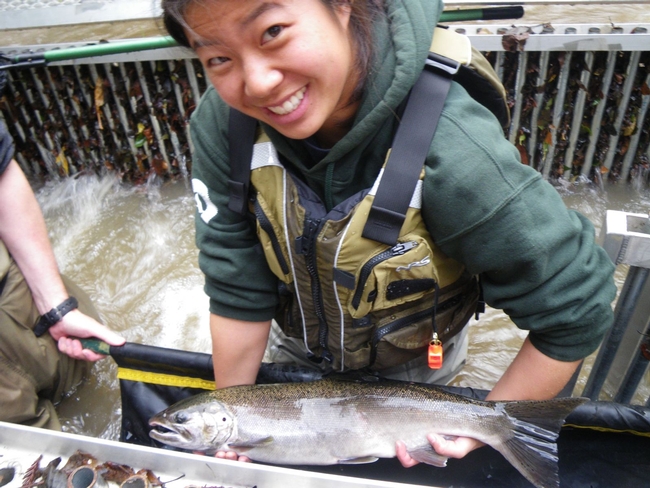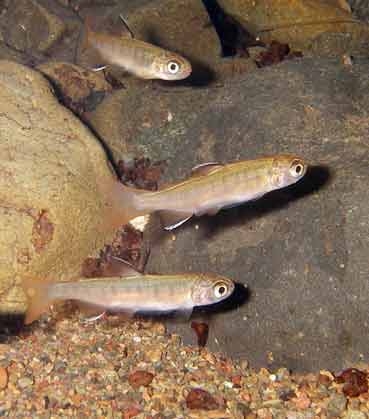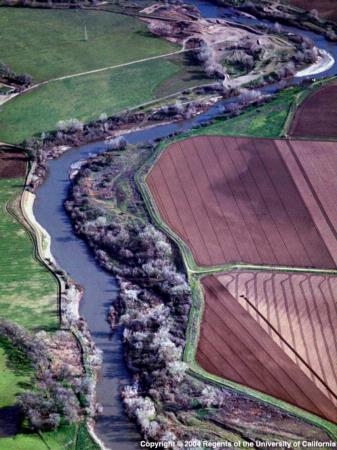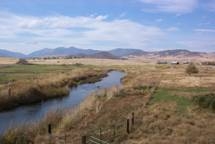
Posts Tagged: salmon
Salmon suffering because of scant rain

Biologists are concerned about any harm done to coho, a fish which is being coaxed back from the brink of extinction but still numbers only in the hundreds.
“There is so much invested in bringing these coho back, from the hatchery program to the restoration work in Dry Creek to the monitoring,” said Mariska Obedzinski, who is monitoring the coho recovery program for the UC Cooperative Extension. “For someone to go out and accidentally catch one when they are in the river, when they could kill or harm them, it is discouraging.”
Corps of Engineers leads coalition effort to save coho salmon
JC Delgadillo, www.army.mil, The U.S. Army
In the winter of 2011, biologists funded by the U.S. Army Corps of Engineers counted a record number of wild juvenile coho salmon in the downstream portions of the Russian River system in western Sonoma County. The project is conducted in collaboration with NOAA's National Marine Fisheries Service, experts at the University of California Cooperative Extension and the Sonoma County Water Agency.
"It's quite the group we have working together," said supervisory fisheries biologist Ben White of the U.S. Army Corps of Engineers. "You've got the best scientific knowledge in the region and people with a deep passion for coho recovery. You've got leaders among their peers working this issue, and I'm proud to be a part of it. You wouldn't be in this field if you didn't care about these fish, and everybody involved wants to see them recover."
Scientists release wasps to control citrus pest
Jeff Spurrier, L.A. at Home blog, Los Angeles Times
On Jan. 6, UC Riverside bio-control specialist Mark Hoddle released 300 tiny parasitic wasps from Pakistan in the L.A. County cities of Pico Rivera, Bell Gardens and South Gate to feed on the Asian citrus psyllid.
The article mentioned that curry leaf, an herb used in Indian cuisine, can be a host for the Asian citrus psyllid.
“If someone has curry leaf and are in the L.A. area, we’d be interested in looking at their plants and maybe using them for our parasite release,” Hoddle said.
The reality of extreme weather, Part 1
Lynne Friedmann, La Jolla Light
It’s not your imagination. Weather is becoming more “extreme,” leading to prolonged heat waves, heavier precipitation, severe flooding, more powerful hurricanes, and intense snowstorms.
Especially problematic is a trend toward long heat waves, during which morality increases, and more humid heat waves resulting in higher nighttime temperatures.
Evening “chill hours” in which the temperature drops below 450º F are also critical for agriculture.
“There are three million acres of fruit orchards with chilling requirements,” said Louise Jackson, UC Cooperative Extension plant physiology specialist. “Increasing humid heat also impacts red wine grape yields.”
Salmon returning in record numbers to the Russian River
California Sea Grant reported this week that a record number of coho salmon were counted in the downstream portions of the Russian River system in western Sonoma County, offering a glimmer of hope that recovery of the endangered silver salmon will be possible.
Adult coho also appear to be reproducing in some of their historical tributaries for the first time since biologists began visually counting, tagging and trapping fish in 2005. The fish appear to be occupying more tributaries of the river system, including some un-stocked creeks.
"There is still a long road to recovery of coho salmon, but the trend is certainly promising," the Sea Grant news release quoted Paul Olin, who oversees the monitoring component of the Russian River Coho Salmon Captive Broodstock Program.
The program is a broad coalition of government agencies, scientists and private landowners dedicated to bringing back productive salmon runs. UC Cooperative Extension is a member.

Wild coho salmon fry in Felta Creek, part of the Russian River watershed. (Photo: California Sea Grant)
Farm economy not as bad as reported
California Sen. Dianne Feinstein fanned a controversy earlier this month when she said she would propose legislation urging the U.S. Fish and Wildlife Service to raise the valley's water deliveries. Her idea was hailed by West Side growers and farmworkers - who say they are suffering economically because of short water supplies - and criticized by environmentalists and many of her fellow democrats - who believe the water is needed to protect delta smelt and salmon.
Yesterday, the Los Angeles Times bolstered the environmentalists' position with an article that said agriculture's reported economic difficulties have been exaggerated.
Times reporter Bettina Boxall wrote that crop and labor statistics for 2009 contradict the image of a withering farm economy teetering on the edge of collapse.
"People make a lot of claims, but the data you see is showing growth. We're just not seeing the job loss," the story quoted Paul Wessen, an economist with the California Employment Development Department.
Boxall also spoke to UC Davis agricultural economist Richard Howitt, who in early 2009 predicted that water cutbacks could cost the valley 80,000 jobs and up to $2.2 billion in revenue. He later revised those numbers to 21,100 farm-related jobs and $703 million in agricultural revenue.
Howitt said farm advocates keep repeating the higher estimates and blame most of the delivery cuts on environmental protections, when they can be more accurately explained by the drought.
Furthermore, the projected economic losses, Howitt said, are "not big" compared to the state's $36 billion farm economy
"But the story is not the aggregate. It's the concentration," Howitt was quoted.
Howitt's report on water supply and demand is available on the UC Agricultural Issues Center Web site.

Delta farmland.
Fish out of water
Fall rains came in just the nick of time for salmon in the Shasta and Scott rivers, according to an article in today's Redding Record-Searchlight. Before the most recent storms, salmon attempting to swim upstream to spawn were trapped in shallow, isolated pools. Agricultural water usage was getting the blame."The irrigation withdrawals are very clearly what is causing the extremely low flows on both rivers," the article quoted Scott Harding, executive director of Klamath Riverkeeper, a nonprofit watchdog group aimed at restoring the river and its tributaries.
Reporter Dylan Darling turned to UC Cooperative Extension advisors Steve Orloff and Dan Drake for comment on agricultural production in the Shasta and Scott river valleys.
Orloff told the reporter that the high-elevation valleys' short growing season places farmers' focus on producing alfalfa, pasture and small grains. Drake said most of the crops are grown to feed cattle. In the two valleys, there are about 40,000 head of cattle combined.
Erica Terence, a spokeswoman for Klamath Riverkeeper, told the reporter she doesn't want to wait for a dramatic fish kill to prompt changes to water use in the valleys.
"I don't think that means the end of farming," Terence was quoted. "I think that means that farming will look different."
Jim Morris, president of the Siskiyou County Farm Bureau and a member of a family with a 200-year farming history in the area, acknowledged that the river goes dry in years of light rain and snowfall.
"It is a natural process and it just happens," Morris was quoted.
Local farmers and ranchers, he said, have taken steps to improve the efficiency of their irrigation systems - such as shifting from flood irrigation to sprinkler systems.
"We'd like to be around for another 200 years," Morris said.

Shasta River (USFWS photo).